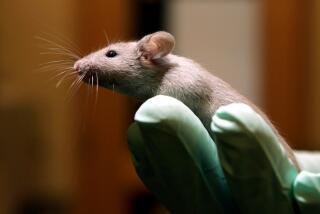Scientists Fail to Offer New Evidence of Fusion : Utah Researchers, Appearing at L.A. Meeting, Retract Some Earlier Statements on Experiment
- Share via
With the scientific world waiting in suspense, chemists B. Stanley Pons and Martin Fleischmann failed in Los Angeles on Monday to deliver on a promise to present new evidence in support of their controversial claim to have created nuclear fusion in a flask.
And, while still clinging to their contention that they have achieved cold fusion, Pons and Fleischmann went on to retract some earlier statements they had made to buttress their seemingly fantastic findings.
Many members of the scientific community agreed that the two researchers--whose experimental claims have been subjected to growing criticism--must present dramatic new results or much more extensive experimental details in order to retain their credibility. James Brophy, vice president for research and development at the University of Utah, said last week that Pons and Fleischmann would offer new support for cold fusion at a meeting this week of electrochemists in Los Angeles.
New Questions
Their failure to do so Monday night raises serious new questions about the validity of Pons’ and Fleischmann’s claims.
“I have always been willing to acknowledge the fact that our experiments may be faulty,” Fleischmann declared at a press conference Monday night. “And for that reason we need to have very full publication” in scientific journals of the cold fusion experiment and of experiments criticizing it.
One major criticism of Pons and Fleischmann, however, is that they did not observe the traditional scientific practice of first publishing their results in a journal. And, since their March 23 claim of cold fusion, they have been criticized for not making results public.
The two chemists said they hope to publish their data in full this summer.
Pons and Fleischmann conceded Monday that their evidence for radioactive byproducts of fusion--a key indicator that fusion occurred--was faulty. Nonetheless, they continued to argue that the evidence of excess heat production in their experiment could not be explained in any other way than by fusion.
Earlier Monday, speaking before 1,600 colleagues of the Electrochemical Society in a ballroom of the Bonaventure Hotel, Pons, of the University of Utah, and Fleischmann, of the University of Southampton in England, offered little more than a rehash of the talks they have presented at other meetings and in testimony before a U.S. Senate committee. Much to the disappointment of the assembled chemists, they did not produce any new details about how their experiments were carried out.
They also failed to address most of the charges that their experiments suffer from major errors in the way they were conducted.
Startling Announcement
Pons and Fleischmann startled the scientific world in March when they announced in Salt Lake City that they could get a sustained fusion reaction in a simple electrochemical apparatus operating at room temperature. Their device consists of palladium and platinum electrodes immersed in so-called heavy water--water in which each hydrogen atom has been replaced by deuterium, which has an extra neutron.
They claimed that applying a small voltage to the electrodes forced deuterium ions to collect at high concentrations inside the palladium electrode. At those concentrations, they said, deuterium ions would fuse into helium atoms, releasing large amounts of energy in the process.
Their announcement sparked the interest of both the public and other scientists because it suggested that large amounts of energy could be obtained inexpensively from the deuterium in sea water. If true, their results held great promise for society, and thousands of scientists throughout the world rushed to duplicate their research.
Scientists were immediately skeptical, however, because the Utah researchers seemed to be obtaining large amounts of energy without the radiation that should have resulted from a fusion reaction. The radiation they said they observed, in fact, was only about one-billionth of the amount that conventional physics said should be present.
Attempts to Duplicate
In the two months that followed their announcement, many small research groups reported that they had duplicated at least part of the two scientists’ results. Large research groups with sophisticated instrumentation, such as the 11 U.S. Department of Energy laboratories and the United Kingdom Atomic Energy Authority’s Harwell Research Laboratory, have been unable to observe any radiation from the electrochemical cells, or any production of excess heat.
Many of these research groups reported their negative results last week at a meeting of the American Physical Society in Baltimore. Additionally, Caltech chemist Nathan Lewis and others reported that a reexamination of the Utah results indicated the presence of a number of fundamental errors.
Among the problems: gamma-radiation assumed to be a sign of fusion probably arose from radon gas in the Utah laboratory; helium in the reaction vessel, also thought to be proof that fusion had occurred, was probably also from the laboratory air; reaction vessels were not stirred, allowing the formation of hot spots that made it appear that the cells were producing more energy than they actually were; and the Utah researchers’ calculation of the energy produced in the cell were based on faulty assumptions.
Pons and Fleischmann conceded Monday night that their method for measuring gamma rays and helium may be defective.
Videotape Evidence
The Utah researchers attempted to show that they did not need to stir the reaction vessel by showing a videotape in which a dye was added to one of their cells, spreading quickly throughout the solution. Nonetheless, Caltech’s Lewis has made careful measurements of actual temperatures throughout the cell and has shown that hot spots exist.
In an unusual move, Pons and Fleischmann had asked the meeting’s organizers to bar press from the technical sessions. Many science writers, however, paid the $205 admission and attended the session. Participants were prohibited from recording the sessions or photographing the highly complicated slides presented by the Utah researchers.






